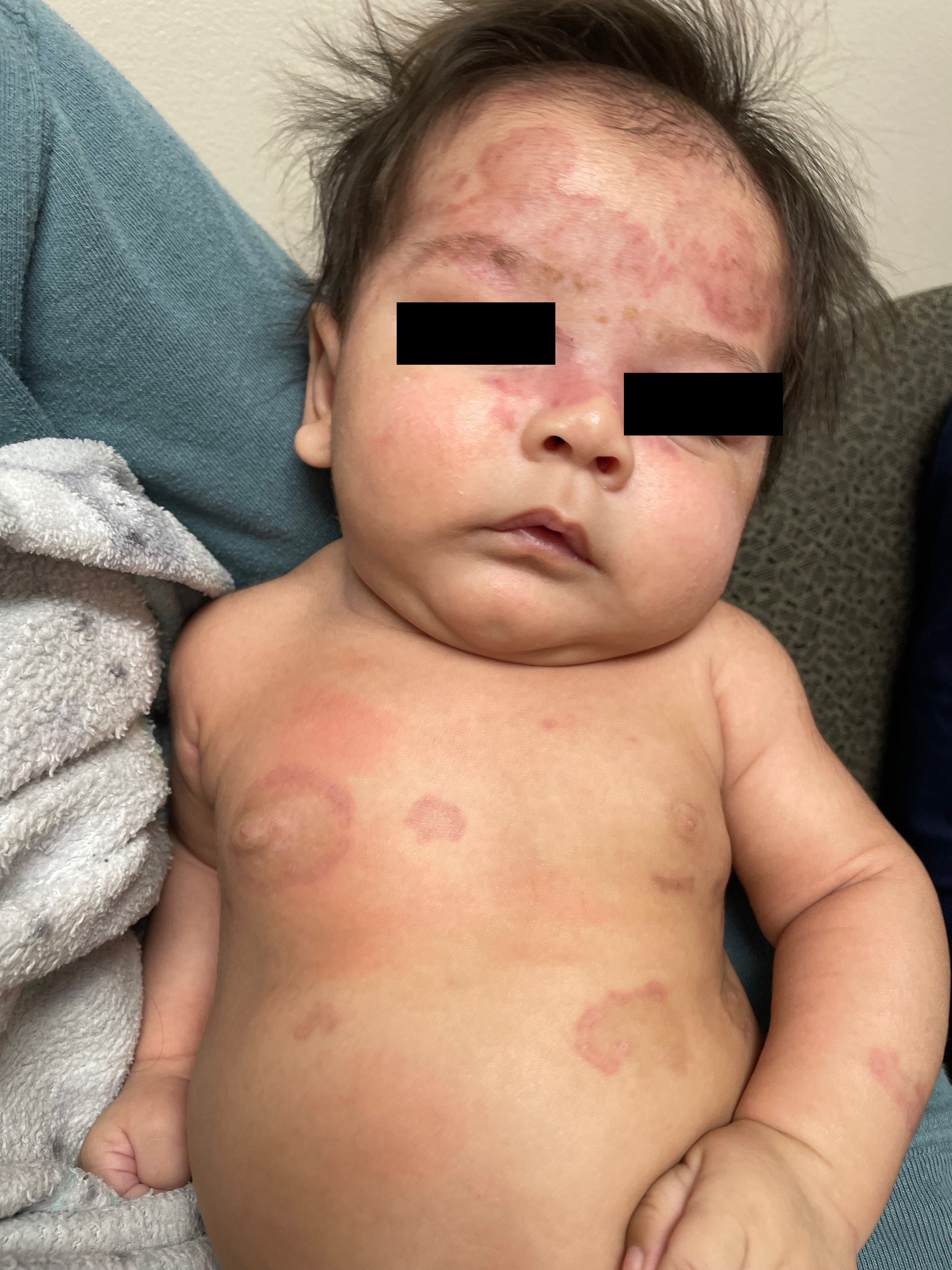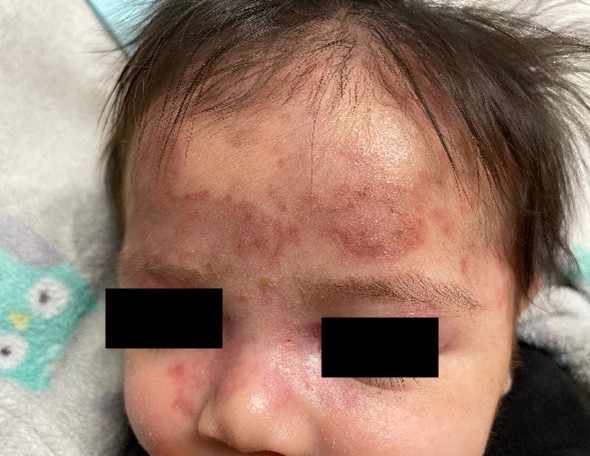Peer Reviewed
Ring Rash in an Infant: Unmasking Neonatal Lupus
A 3-month-old boy presented to the dermatology clinic with large erythematous plaques that appeared in the first few weeks of life, localized to the face, back, and torso (Figures 1-3).

Figure 1. Anterior view of 3-month-old infant with annular rash. A diffuse reddish/purple annular rash is localized to face and torso. Lesions on torso show hyperpigmentation and surrounding erythema.

Figure 2. Close up cephalic view of 3-month-old infant with annular rash. Facial lesions are distributed on the forehead, eyelids, and nasal bridge. Rash spares nasolabial folds.

Figure 3. Posterior trunk view of 3-month-old infant with annular rash. Lesions appear reddish/purple and are localized to the midline of the back. Moderate scaling of lesions and surrounding erythema is seen.
History. The mother states that the rash appeared on the infant soon after birth, 3 months ago. There were no complications during her delivery and she regularly attended her prenatal checkups. The patient’s mother states a previous presumptive diagnosis of seborrheic dermatitis and erythema multiforme were made a month prior by the infant's pediatrician, but the prescribed selenium shampoo provided no improvements after 10 days.
Upon further questioning, the mother’s past medical history is significant for systemic lupus erythematosus (SLE) for which she takes hydroxychloroquine. She notes that her SLE-associated symptoms seemed to worsen during this pregnancy. She reports that no household contacts have presented with a similar rash. She also denies usage of any new personal care products or medications on the infant. The mother confirms that the patient is gaining weight, stooling, and voiding without issues.
She confirms no signs of blisters, cough, chills, or diarrhea. On physical examination, the infant is in no acute distress. Multiple large ring-like reddish/purple plaques are identified, with associated scaling and erythema. The lesions are on the face, torso, and back. There were no signs of jaundice or hepatomegaly. However, a systolic heart murmur initially identified by the patient’s pediatrician was further confirmed. The infant was recorded with the following growth parameters: weight 4th percentile, length 1st percentile, and head circumference 56th percentile.
Diagnostic testing. Results from the patient’s complete blood count and hepatic function tests were all within normal limits. An autoantibody analysis showed positive titers for anti-SSA/Ro, and anti-SSB/La, but negative titers for anti-U1RNP (Table 1).
Test Name | Result | Reference Range |
SSA/Ro Antibodies, IgG | >240.0 U/mL (positive) | 0.0-6.9 U/mL |
SSB/La Antibodies, IgG | 154.0 U/mL (positive) | 0.0-6.9 U/mL |
U1RNP Antibodies, IgG | 0.5 U/mL | 0.0-4.9 U/mL |
|
|
|
White Blood Count | 10.0 K/μL | 5.5-18.0 K/μL |
Red Blood Count | 3.60 M/μL | 3.40-5.20 M/μL |
Platelets | 356 K/μL | 150-400 K/μL |
|
|
|
AST | 35 | 0-120 U/L |
ALT | 20 | 3-45 U/L |
Table 1. Diagnostic workup results. Relevant values from the patient’s autoantibody titers, complete blood count with platelet differential, and liver panel.
Based off these laboratory values, the clinical history, and physical examination, a diagnosis of neonatal lupus erythematous (NLE) was made.
Differential diagnoses. Although the diagnosis of NLE was confirmed by the presence of SSA and SSB titers, several dermatological conditions present with similar erythematous ringlike rashes on neonates which must be differentiated.
Neonatal erythema multiforme is a hypersensitivity reaction that occurs most commonly secondary to viral infections like herpes simplex virus, but also certain medications, immunizations, and malignancies.1 Unlike NLE, its lesions appear as fixed targetoid lesions typically distributed on both the skin and mucosal surfaces. In addition to being extremely rare in infancy, the lesions typically spontaneously resolve within weeks, which was not seen in our patient. Diagnosis is clinically made through history and physical examination.1
Neonatal tinea corporis, a fungal infection, is often caused by skin contact between the mother and child.2 Its characteristic lesion looks like NLE with a well-defined, erythematous, scaly patch with a central clearing. However, unlike NLE, tinea corporis does not present with atrophy.3 Furthermore, considering its contagious nature, multiple household members can be affected at the same time.2 Diagnosis is confirmed through microscopy on KOH preparation or by culture of skin scrapings.3
Granuloma annulare has an unclear etiology. It can be associated with trauma, infections, and autoimmune processes.4 It presents as raised, annular, or semi-circular plaques with a central depression. However, unlike NLE these lesions are more commonly located on the extremities, not the whole body. Furthermore, this pathology is uncommonly seen in this age group. Diagnosis is usually clinical but confirmed through a biopsy showing characteristic granulomatous inflammation.4
Treatment and management. Following the diagnosis of NLE, a 2.5% hydrocortisone topical ointment was prescribed. Instructions were given to apply the ointment to affected areas twice daily for 1-2 weeks, and then every other day as needed. The mother was informed that disease severity and occurrence is not exacerbated by breastfeeding, so she can continue if comfortable.5 Additionally, a consultation was planned with pediatric cardiology for evaluation of the patient’s heart murmur and to rule out a potential atrioventricular heart block complication.
Outcome and follow-up. On follow-up examination 8 weeks later, the infant was now 5 months old. There was marked improvement in his lesions following adherence to the prescribed treatment regime (Figures 4 and 5). The previous large rashes of the face, thorax, and back were nearly completely resolved. The mother was encouraged to continue treatment as directed until the complete resolution of lesions. Additionally, the consulted cardiologist ruled out heart block.

Figure 4. Anterior view following 2.5% hydrocortisone treatment. Post-treatment improvement in lesions of the face and trunk. Slight erythema of the nasal bridge and forehead remains. Only two annular lesions remain on the chest.

Figure 5. Posterior view following 2.5% hydrocortisone treatment. Treatment has greatly improved the atrophic annular rash localized on the infant’s back. The lesion has substantially decreased in intensity and size.
Discussion. NLE is an autoimmune condition that can arise in newborns of mothers with positive titers of specific autoantibodies. These autoantibodies can be passed to the child through the placenta.6 Most commonly, anti-SSA/Ro and anti-SSB/La are implicated, which are found in patients with Sjogren syndrome (90% positive) and SLE (20%-30% positive.) Less commonly implicated in NLE is anti-U1 RNP, which is a specific autoantibody found in mixed connective tissue disease (MCTD). In mothers with these autoantibodies, approximately 2% of their infants will manifest a lupus-like-syndrome.6
NLE presents a non-pruritic rash localized to the face and scalp (most common), trunk, and extremities. These lesions appear as erythematous coalescent plaques with raised margins and central clearing. Additional signs of a fine scale, hyperpigmentation, telangiectasias, and atrophy may also be present.7 The cutaneous manifestations of NLE are self-limited and non-threatening. It is expected that 80% of patients will have symptoms resolve spontaneously within 7 months and nearly 100% by 12 months.6 However, for cases of widespread lesions causing significant distress, as seen in our patient, low potency topical corticosteroids can be prescribed to expediate resolution.
The extracutaneous manifestations of NLE can range from potentially life-threatening to fully asymptomatic. Firstly, suppression of the hematologic lineages by autoantibodies can cause transient thrombocytopenia (most common), neutropenia, and anemia in neonates.8 These findings are mostly always asymptomatic and resolution should be expected within the first year. In rare cases, bleeding problems may occur, but an increased risk of infection has not been noted.8 Secondly, mild hepatomegaly may be associated with a transient increase in liver enzymes and conjugated bilirubin.9 Cases of this progressing to acute liver failure have been reported, but its prevalence is currently unclear.9 Lastly, the most well-known complication of NLE is related to its cardiac involvement. Congenital heart block has up to a 25% risk of fetal demise.10 In addition to causing valvular abnormalities and cardiomyopathies, it can cause first, second, or third-degree atrioventricular heart block. In fact, within the first 30 days of life, NLE accounts for 80% to 95% of cases of severe atrioventricular block in neonates.6 In these cases, preliminary literature recommends dexamethasone 4 mg to 8 mg daily, stepping up to intravenous immunoglobulin administration or pacemaker if indicated.10
Overall, we highlight the importance that physicians of various specialties are knowledgeable of the etiology, signs, and management of NLE. Given its characteristic rash, early diagnosis of this disease can help negate the occurrence of severe complications of the disease, such as atrioventricular heart block. We encourage further unmasking and identification of this often-missed pathology by health care providers in all specialties.
- Kim JJ, Lee JK. Neonatal erythema multiforme associated with a rotavirus infection: a case report. World J Clin Cases. 2023;11(24):5749-5754. doi:10.12998/wjcc.v11.i24.5749.
- Warren LJ, Tilakaratne D, Seth R. Neonatal tinea corporis. Med J Aust. 2017;207(8):324. doi:10.5694/mja17.00599.
- Rizvi AA, Kanwar AJ. Tinea corporis in an 8-day-old infant. Indian J Pediatr. 2016;17(2):153-154. doi:10.4103/2319-7250.175652
- Joshi TP, Duvic M. Granuloma annulare: an updated rreview of epidemiology, pathogenesis, and treatment options. Am J Clin Dermatol. 2022;23(1):37-50. doi:10.1007/s40257-021-00636-1.
- Alotiby AA. The role of breastfeeding as a protective factor against the development of immune-mediated diseases: a systematic review. Front Pediatr. 2023;16;11:1086999. doi:10.3389/fped.2023.1086999.
- Diaz-Frias J, Badri T. Neonatal Lupus Erythematosus. StatPearls Publishing; 2023. Accessed December 20th, 2023. https://www.ncbi.nlm.nih.gov/books/NBK526061/
- Derdulska JM, Rudnicka L, Szykut-Badaczewska A, et al. Neonatal lupus erythematosus - practical guidelines. J Perinat Med. 2021;49(5):529-538. doi: 10.1515/jpm-2020-0543. PMID: 33470961.
- Silverman E, Jaeggi E. Non-cardiac manifestations of neonatal lupus erythematosus. Scand J Immunol. 2010;72(3):223-225. doi:10.1111/j.1365-3083.2010.02443.x
- Nguyen EL, Huang AC, Khalsa UK, et al. Acute liver failure in neonatal lupus erythematosus: novel treatment with exchange transfusion, intravenous immunoglobulin, and steroids. JPGN Rep. 2021;2(2):pe057. doi:10.1097/PG9.0000000000000057
- Clowse MEB, Eudy AM, Kiernan E, et al. The prevention, screening and treatment of congenital heart block from neonatal lupus: a survey of provider practices. Rheumatology (Oxford). 2018;1;57(5):v9-v17. doi:10.1093/rheumatology/key141.
AFFILIATIONS:
1Medical Student, College of Osteopathic Medicine, Michigan State University, Grand Blanc, MI
2Assistant Professor, Department of Pediatrics, College of Osteopathic Medicine, Michigan State University, East Lansing, MI
3Medical Student, College of Osteopathic Medicine, Michigan State University, Macomb, MI
CITATION:
Siddique AS, Thakur KS, Barlow LC, Gallagher ML. Ring rash in an infant: unmasking neonatal lupus. Consultant. 2024;64(6):e2. doi:10.25270/con.2024.05.000005
Received January 21, 2024. Accepted February 22, 2024. Published online May 29, 2024.
DISCLOSURES:
The authors report no relevant financial relationships.
ACKNOWLEDGEMENTS:
None.
CORRESPONDENCE:
Aashir S. Siddique, BSc 965 Wilson Road, East Lansing, MD 48824 (siddi115@msu.edu)


